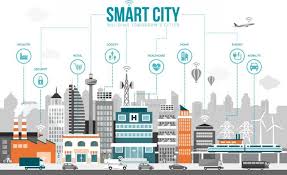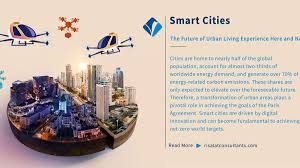
Cities have always been centers of innovation, culture, and opportunity. But in 2025, urban living is undergoing a radical transformation—fueled not by concrete and steel alone, but by data, sensors, and intelligent systems. Welcome to the era of smart cities, where technology isn’t just making life more convenient—it’s reshaping how cities breathe, move, grow, and respond.
But what exactly makes a city “smart”? And how is this technology-driven vision improving life for millions around the world?
Let’s explore how smart cities are being built—and what they mean for our future.
What Is a Smart City?
A smart city is an urban area that uses technology, connectivity, and data to improve the quality of life for its residents. This includes making transportation smoother, energy cleaner, streets safer, and services more efficient.
At the heart of every smart city is a simple idea: using information to solve real-world problems. Sensors, AI, and IoT (Internet of Things) devices work together to collect and analyze data in real-time, enabling city systems to adapt, predict, and optimize operations.
In short, a smart city is designed to think, learn, and improve—just like a living organism.
1. Smarter Transportation, Smoother Living
In many smart cities of 2025, getting from point A to point B is faster, greener, and less frustrating.
- AI-driven traffic lights adjust in real time based on congestion patterns.
- Smart parking systems guide drivers to open spots before they even enter a lot.
- Public transit apps provide live updates, crowd size estimates, and route optimizations.
- Electric and autonomous vehicles are being integrated into fleets, reducing emissions and road accidents.
In places like Singapore, Tokyo, and Helsinki, mobility-as-a-service (MaaS) platforms are combining bike shares, buses, trains, and ride-hailing into one seamless experience—all bookable via a single app.
2. Energy That Thinks Before You Plug In
Smart cities aim to reduce their carbon footprint—and tech is helping lead the charge.
- Smart grids adjust energy flow based on real-time demand.
- Connected buildings use sensors to regulate lighting, temperature, and water usage automatically.
- Solar panels and microgrids allow cities to generate and store their own renewable energy.
Cities like Copenhagen and Amsterdam are using real-time energy monitoring to hit aggressive climate goals, proving that sustainability and efficiency can go hand in hand.
3. Safer, Healthier Urban Spaces
Safety isn’t just about police patrols—it’s about smart planning and quick responses.
- Connected streetlights increase brightness when motion is detected at night.
- AI surveillance systems detect unusual activity or emergencies and alert first responders instantly.
- Air quality sensors inform city officials where pollution spikes occur, allowing targeted clean-up efforts.
During health crises like pandemics, smart cities can adapt rapidly—using tech to manage crowd flows, deliver health updates, and coordinate resources.
4. Digital Government, Real-Time Services
In a smart city, waiting in line at a government office is becoming a thing of the past.
- Digital IDs and mobile apps allow citizens to pay taxes, request documents, and report issues from their phones.
- Chatbots and virtual assistants provide 24/7 support for public services.
- Open data platforms give citizens access to city information, boosting transparency and civic engagement.
Estonia is often held up as a model for e-governance, with over 99% of public services available online.
5. Data-Driven Urban Planning
Smart cities don’t grow randomly—they evolve based on real-world insights.
Urban planners now use:
- Satellite imagery and AI models to predict population growth and infrastructure needs
- Traffic heatmaps to redesign roads and bike lanes
- 3D simulations to visualize how a new building will affect wind, sunlight, and pedestrian flow
This data-centric approach helps create cities that are not only efficient, but also more inclusive, accessible, and livable.
6. The Role of 5G and IoT
The backbone of every smart city is connectivity. In 2025, the rollout of 5G networks and billions of connected IoT devices has made ultra-fast, low-latency communication possible.
From smart trash bins that notify sanitation crews when full, to wearable health monitors for elderly residents, to drones that monitor infrastructure—IoT is allowing cities to operate like intelligent, self-regulating ecosystems.
Challenges on the Road to Being “Smart”
Despite the promise, building a smart city isn’t easy—and it’s not just about the tech.
Major challenges include:
- Privacy concerns: Who owns and controls the data collected from citizens?
- Cybersecurity threats: More devices mean more opportunities for hacking.
- Digital inequality: Not everyone has equal access to the internet or smart devices.
- High costs: Infrastructure upgrades and maintenance require major investment.
- Interoperability: Getting different systems and vendors to work together remains a major hurdle.
These issues must be addressed thoughtfully to ensure that smart cities serve everyone—not just the tech-savvy or wealthy.
So, Are Smart Cities the Future?
Absolutely—but with a big caveat: they must be built with people at the center.
The smartest cities of the future won’t be the ones with the most sensors or fastest internet—they’ll be the ones that use technology to solve real human problems, reduce inequality, and foster vibrant, sustainable communities.
Smart doesn’t just mean digital. It means thoughtful, ethical, inclusive, and resilient.
Final Thoughts
In 2025, smart cities are no longer science fiction—they’re being built in real time. From Tokyo’s high-tech infrastructure to Nairobi’s mobile-first services, the fusion of technology and urban living is already reshaping the 21st century.
